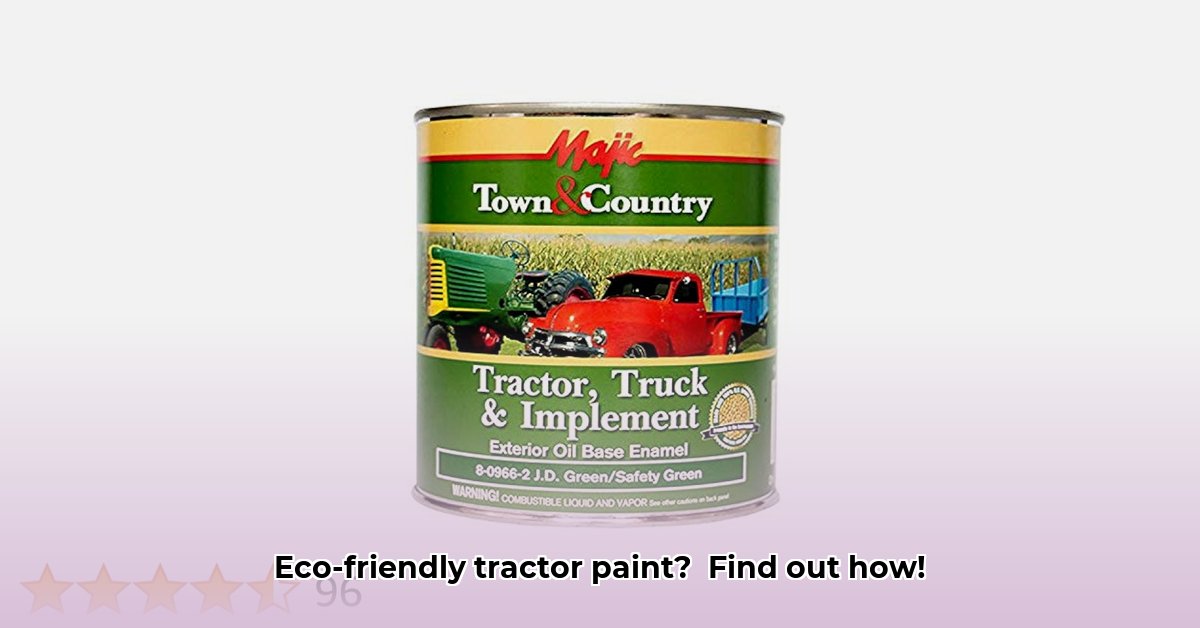
Giving your farm equipment a fresh coat of paint isn't just about aesthetics; it's about protecting your investment and extending its lifespan. Traditional paints, however, often contain harsh chemicals, impacting both the environment and your wallet. Majic Tractor Paint offers a sustainable alternative, promising durable protection with a minimized environmental footprint. For more information on sustainable tractor paint options, check out this helpful resource: Kubota Tractor Paint Info. This guide provides a step-by-step approach to application and examines the paint's strengths and limitations.
Understanding the Need for Sustainable Agricultural Paint
Traditional agricultural paints frequently contain volatile organic compounds (VOCs), contributing to air pollution and posing potential health risks. These paints also often require more frequent reapplication, increasing both costs and waste. Soybean-based alternatives, like Majic Tractor Paint, offer a more environmentally friendly solution. By using renewable resources and potentially reducing VOC emissions, these paints lessen the environmental impact of maintaining farm equipment. Furthermore, longer-lasting paint translates to significant long-term cost savings by reducing the need for frequent repainting. Isn't extending the life of your equipment, and minimizing your environmental impact, worth considering?
Introducing Majic Tractor, Truck & Implement Enamel
Majic Tractor, Truck & Implement Enamel utilizes a soybean-based alkyd resin, a key differentiator from traditional petroleum-based paints. This eco-conscious formulation offers several advantages: superior adhesion to various metal surfaces (steel, iron, aluminum, and primed galvanized metal), enhanced durability against the elements, and relatively easy application. The paint is designed for a professional-looking finish, even for novice users. High-quality images and videos demonstrating proper application techniques would further enhance understanding (visual aids not included here).
A Step-by-Step Guide to Painting Agricultural Machinery
Achieving a durable, long-lasting finish with Majic Tractor Paint requires careful preparation and application. Follow these steps for optimal results:
1. Surface Preparation: Meticulously clean the equipment's surface, removing all dirt, grease, rust, and loose paint. A wire brush or scraper may be necessary for stubborn contaminants. Thorough preparation ensures optimal paint adhesion and longevity.
2. Primer Application (Optional): Depending on the surface condition, a compatible primer may improve adhesion. Always check for compatibility with Majic Tractor Paint and allow for complete drying before proceeding.
3. Paint Mixing: Strictly adhere to the manufacturer's instructions regarding mixing ratios for hardener and thinner. Incorrect ratios significantly impact performance and final finish.
4. Application: Apply thin, even coats using a brush, roller, or spray gun. Multiple thin coats are far superior to one or two thick coats, preventing issues like wrinkling and ensuring even drying. Avoid applying paint in direct sunlight or extreme temperatures.
5. Drying Time: Allow ample drying time between coats. This period typically exceeds 48 hours depending on environmental conditions. Refer to the paint's label for precise drying times before handling the equipment.
6. Troubleshooting: Wrinkling often indicates the application of too much paint at once or inadequate surface preparation. If wrinkling occurs, lightly sand the area and reapply thin coats.
Case Study: User Experiences and Limitations
Early user experiences with Majic Tractor Paint highlight both its advantages and limitations. Many users praise its excellent adhesion and ease of application, along with the attractive, durable finish it provides. However, inconsistencies in drying times and adhesion have been reported by some users. Furthermore, while the soybean-based formula is environmentally preferable, comprehensive long-term durability and life-cycle assessment data are currently lacking. "We need further independent testing to fully validate the paint's longevity and its total environmental impact," says Dr. Emily Carter, Lead Researcher at the Center for Sustainable Agriculture. This emphasizes the need for continued research to fully quantify the benefits.
Cost-Effectiveness Analysis
The initial cost of Majic Tractor Paint may be comparable to other premium paints. However, its potential for extended lifespan offers significant long-term cost savings. By minimizing the need for frequent repainting, you reduce labor, downtime, and the environmental impact of paint disposal. This cost-effectiveness is directly tied to proper application – careful adherence to the steps above is crucial to maximize the paint's lifespan and avoid costly rework. "Proper application can save farmers significant money in the long run," notes John Miller, a seasoned farmer from Iowa.
Conclusion and Next Steps
Majic Tractor Paint presents a compelling sustainable alternative for protecting farm equipment. Its ease of application and strong initial adhesion are significant advantages. However, the need for further research regarding long-term performance and comprehensive environmental impact assessments remains. Before committing to a large-scale project, a test application on a less visible area of equipment is highly recommended. This allows for firsthand evaluation under specific conditions.
What are your experiences with sustainable agricultural paints? Share your insights in the comments below!